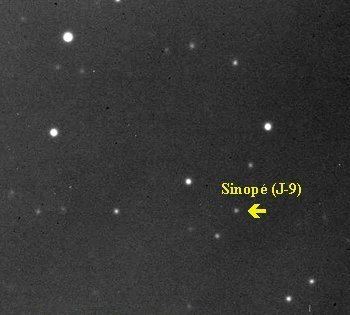Discovered by S. B. Nicholson Periapsis 18,237,600 km Mean orbit radius 23,540,000 km Orbital period 770 days | Discovery date July 21, 1914 Apoapsis 30,191,200 km Eccentricity 0.25 Discovered 21 July 1914 | |
 | ||
Similar Seth Barnes Nicholson discoveries, Jupiter moons, Other celestial objects | ||
Sinope (/sᵻˈnoʊpiː/ sə-NOH-pee; Greek: Σινώπη) is a retrograde irregular satellite of Jupiter discovered by Seth Barnes Nicholson at Lick Observatory in 1914, and is named after Sinope of Greek mythology.
Contents
Sinope did not receive its present name until 1975; before then, it was simply known as Jupiter IX. It was sometimes called "Hades" between 1955 and 1975.
Sinope was the outermost known moon of Jupiter until the discovery of Megaclite in 2000. The most distant moon of Jupiter now known is S/2003 J 2.
Orbit
Sinope orbits Jupiter on a high eccentricity and high inclination retrograde orbit. The orbital elements are as of January 2000. They are continuously changing due to solar and planetary perturbations. It is often believed to belong to the Pasiphae group. However, given its mean inclination and different colour, Sinope could be also an independent object, captured independently, unrelated to the collision and break-up at the origin of the group. The diagram illustrates Sinope's orbital elements in relation to other satellites of the group.
Sinope is also known to be in a secular resonance with Jupiter, similar to Pasiphae. However, Sinope can drop out of this resonance and has periods of both resonant and non resonant behaviour in time scales of 107 years.
Physical characteristics
Sinope has an estimated diameter of 38 km (assuming an albedo of 0.04) The satellite is red (colour indices B−V=0.84, R−V=0.46). unlike Pasiphae, which is grey.
Its infrared spectrum is similar to D-type asteroids also different from Pasiphae. These dissimilarities of the physical parameters suggest a different origin from the core members of the group.
